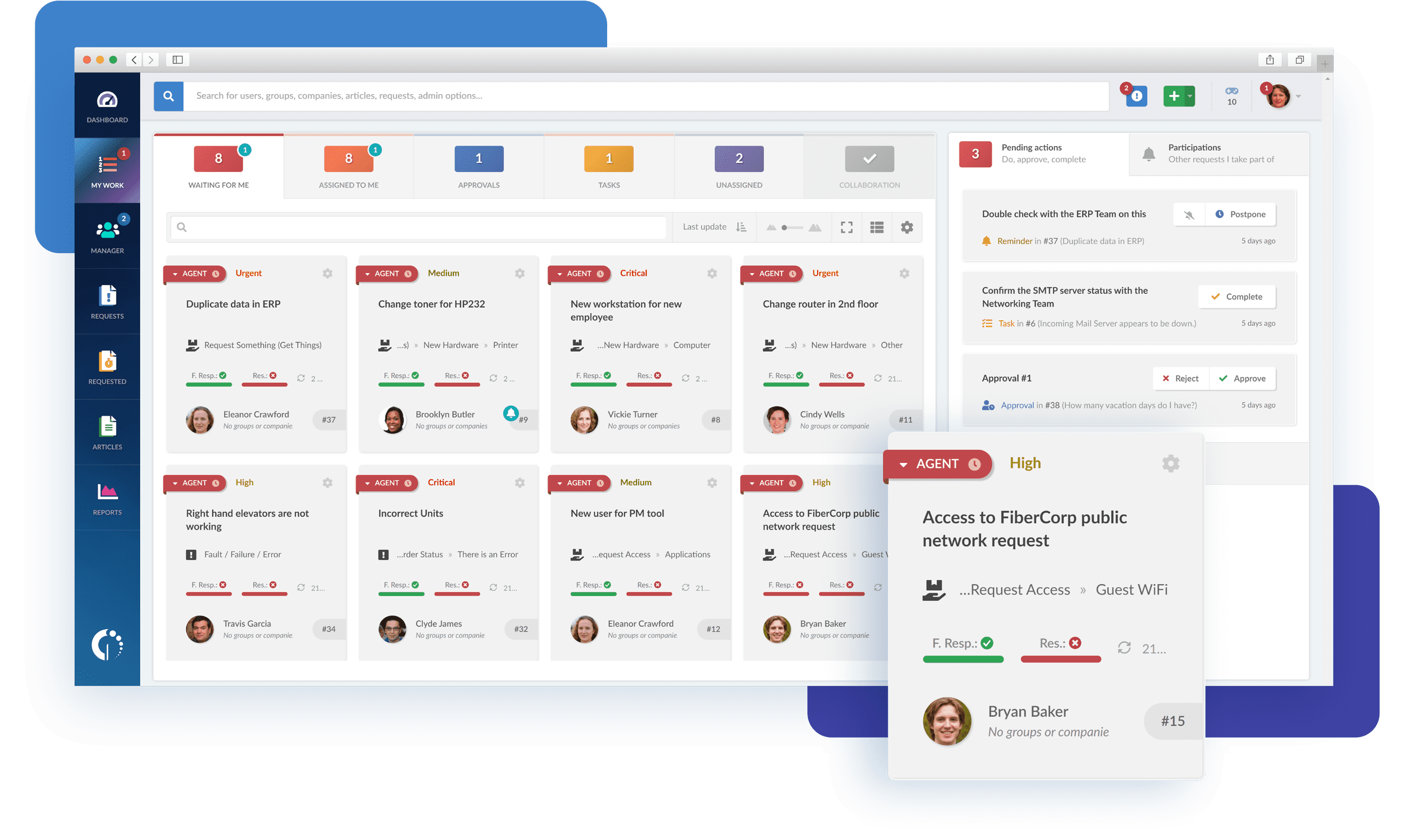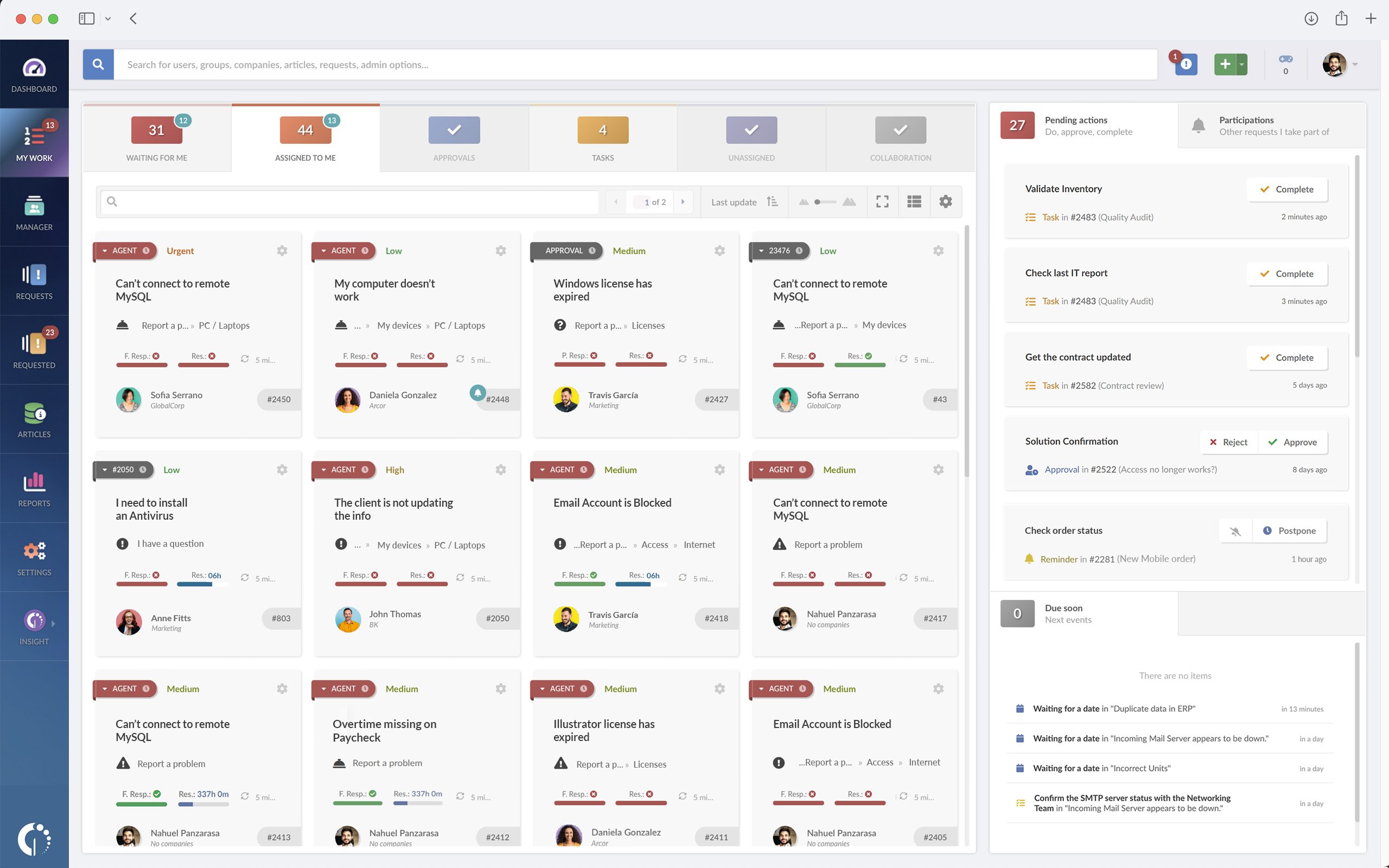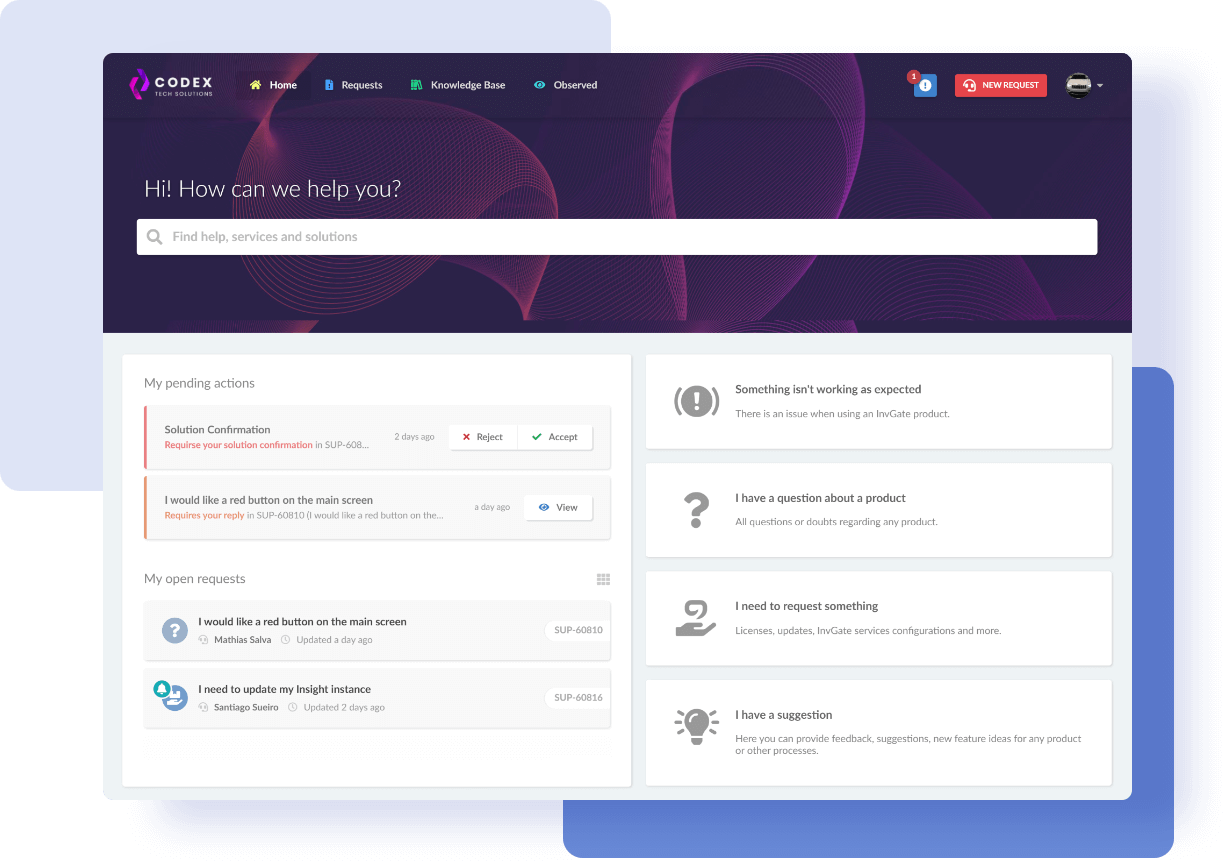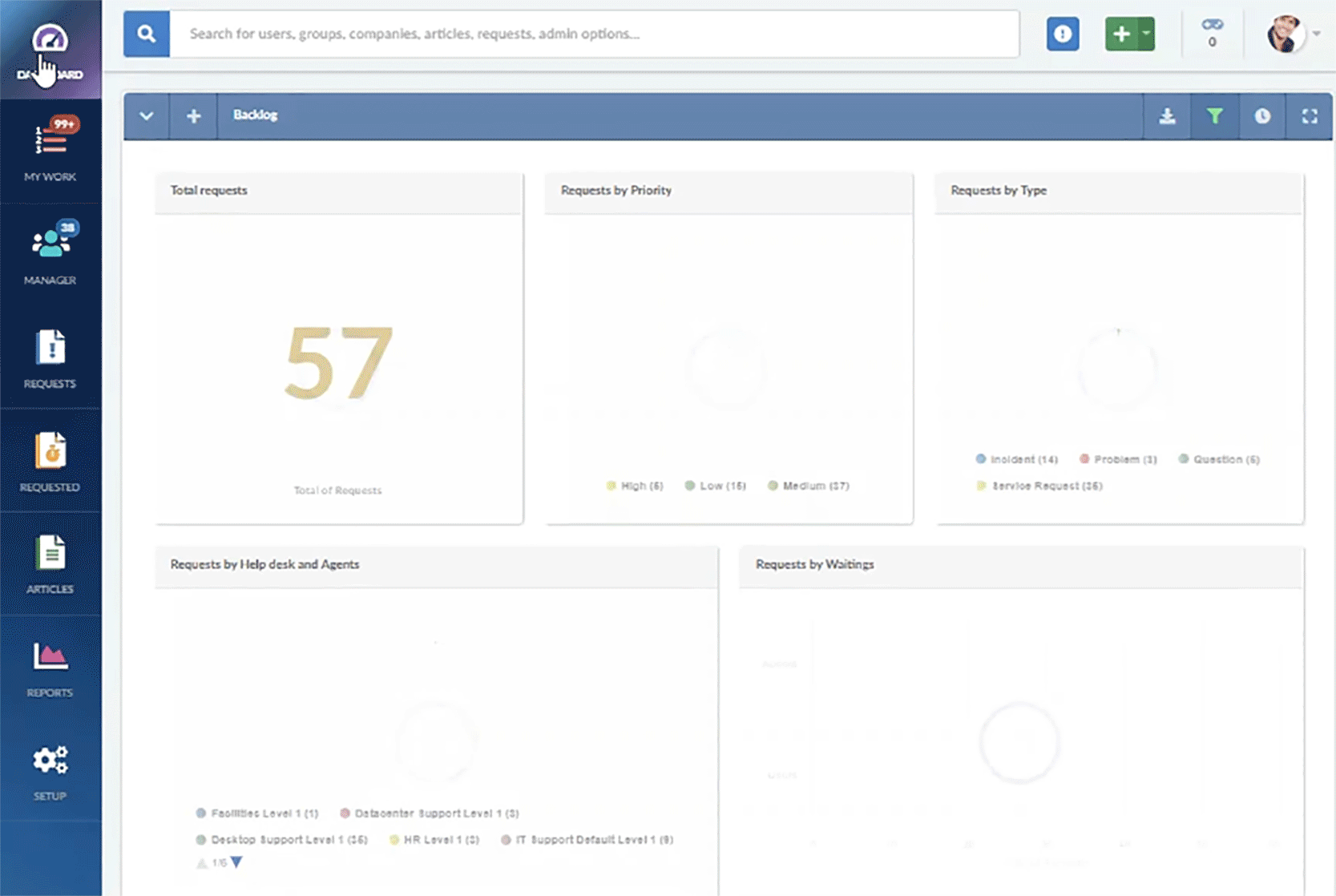When faced with the decision between Zendesk vs. Cherwell Service Management, it becomes imperative to carefully assess their respective features, strengths, and weaknesses to determine the best fit for your unique needs. Choosing the right IT Service Management (ITSM) solution is a critical decision that can significantly impact the efficiency and effectiveness of your organization's operations.
In this blog post, we’ll embark on an in-depth ITSM tools comparison between these two platforms. However, the ITSM landscape is dynamic, and so we’ll also introduce a third alternative: InvGate Service Management. This service desk software is not to be overlooked, offering streamlined functionalities and a strong emphasis on digital transformation.
- What is Zendesk?
- What is Cherwell Service Management?
- Considering InvGate Service Management as an ITSM solution alternative
Let’s start!
Most looked-at features by buyers
When buyers are in the process of evaluating ITSM solutions, they focus on identifying specific features that meet their organization's needs. These desired features because they play a critical role in making an informed decision.
Let's look at some of the fundamental aspects that potential buyers typically focus on when comparing different ITSM tools.
- Ticket Management solution - Buyers assign significant value to have a comprehensive Ticket Management system within their help desk software. This feature enables effective tracking, assignment, and resolution of customer inquiries and support requests.
- Efficient Asset Management - Users prioritize software that provides robust IT Asset Management capabilities, helping them maintain accurate inventories and optimize resource utilization within their organizations.
- Self-service portal and knowledge base - The inclusion of a self-service portal is highly valued by buyers, as it empowers end-users to independently resolve common issues and access relevant information without requiring direct assistance.
- Support automation and Workflow Management - Buyers actively seek out software solutions equipped with automation capabilities to simplify routine tasks like ticket routing, approvals, and escalations. These automation features significantly contribute to increased efficiency and productivity.
- Streamlined IT service catalog - Many organizations require a service catalog that enables users to request specific IT services or resources. This feature simplifies service requests, provides visibility into available services, and facilitates effective service delivery management.
- Insightful reporting - Buyers seek help desk software with powerful reporting tools such as dashboards and reports, offering valuable insights into their IT operations and performance. This data-driven approach facilitates informed decision-making and continuous service improvement.
- Scalability - Organizations experiencing growth and evolving needs prioritize solutions that can seamlessly adapt to their expansion while allowing customization. It's critical for the chosen solution to offer the ability to create custom fields, workflows, and extensions/plugins, thereby enabling tailoring to their unique business requirements.
- User experience and interface - Buyers consider the user experience and interface of the platform, focusing on its ease of use and how it enhances user adoption and productivity. They appreciate an intuitive interface that is user-friendly and promotes efficient interaction with the software. For organizations with remote or mobile workforces, mobile accessibility is also a key factor to consider.
- Customization and flexibility - Buyers appreciate software solutions offering customization options, allowing them to tailor the platform to meet their business needs. This flexibility ensures the software aligns seamlessly with their unique workflows and processes, ultimately enhancing user satisfaction and overall effectiveness.
- Seamless integration capabilities - Integration with other systems and applications is a critical requirement for buyers, as it ensures the smooth flow of data and process automation. The ability to integrate with existing tools and platforms is highly prized for improved efficiency and a unified user experience.
- ITIL compliance - Many organizations adhere to ITIL best practices for IT Service Management. Buyers may prioritize solutions that support ITIL processes like Incident Management, Problem Management, Change Management, and Asset Management, as these processes align with their organizational standards.
- Pricing and support - Buyers evaluate the solution's cost-effectiveness, including licensing models, subscription plans, and any additional costs related to features or users. The availability of customer support, documentation, and training resources also significantly influences their decision-making process.
What is Zendesk?
Zendesk for Service is a feature-rich solution tailored to meet the needs of IT Service Management in businesses.
Zendesk Inc. is a software development firm that specializes in customer service solutions delivered through a software-as-a-service (SaaS) approach. This platform equips organizations with tools for individual customer interactions, predictive analysis for common customer questions, data collection, engaging with customers, and gaining valuable insights. It has a global presence in different parts of the world, including Europe, Asia Pacific, Latin America, and North America.
What users like from Zendesk
Customers have highlighted numerous benefits of Zendesk, as evidenced by reviews from reputable sources such as Gartner. Here are some of the benefits that have been recognized.
- Comprehensive reporting and analytics - Zendesk Explore offers a comprehensive suite of options for reporting and querying, facilitating well-informed decision-making and robust performance tracking.
- Extensive feature set - The tool has introduced a range of valuable features, including capabilities for multichannel messaging, workflow management through the flow builder, and advanced knowledge management tools. The Admin Center simplifies configuration tasks, making the platform's complexity more manageable.
- Exceptional customization - The platform's user interface is notably customizable, empowering businesses to tailor it to meet their unique requirements precisely.
- Seamless multichannel support - The software excels in managing multichannel tickets, seamlessly integrating with social media, chat applications, and traditional communication channels like email. This integration ensures that agents can work efficiently within a unified workspace.
- Vast app marketplace - Zendesk provides access to a marketplace with over 1,200 third-party applications and integrations. This marketplace is a valuable resource for organizations seeking to expand their ITSM capabilities.
What users don’t like from Zendesk
While Zendesk has many strengths and positive attributes, customers have also expressed criticism and reservations about certain aspects of the platform. These criticisms have been identified through assessments conducted by sources such as Gartner. Here are some of the unfavorable aspects that have come to light.
- Pricing challenges across business sizes - Zendesk's pricing structure can be challenging for small and mid-sized businesses. The starting cost of $49 per agent per month, along with the need for higher-priced plans to access enterprise-level features, can be a barrier.
- Integration and compatibility considerations - The software seamlessly integrates with third-party applications and its proprietary CRM solution, Zendesk Sell. Nevertheless, users often find it necessary to subscribe to higher-tier plans to fully harness these capabilities.
- Limited dashboard customization - Full customization of dashboards is constrained for users on lower-tier plans. It is predominantly accessible at the Enterprise level. This restriction can impede the ability to tailor analytics views to specific requirements.
- Reporting limitations - While Zendesk's Explore tool offers a variety of reporting options, it's crucial to note that users on an Enterprise plan experience notable constraints in dashboard customizations. Users have suggested that Zendesk should improve this aspect, particularly in relation to its pricing structure.
What’s Zendesk’s argument over Cherwell Service Management?
Zendesk presents a compelling argument over Cherwell Service Management, bolstered by a range of robust features and advantages that set it apart in the realm of customer support and Service Management software.
- Comprehensive reporting and analytics - Zendesk's offering, Zendesk Explore, stands out with its comprehensive suite of reporting and querying options. This feature empowers organizations to make well-informed decisions and enables robust performance tracking, providing deep insights into customer interactions and service metrics.
- Extensive feature set - Zendesk has an extensive feature set that includes valuable capabilities such as multichannel messaging, Workflow Management through the flow builder, and advanced knowledge management tools.
- Exceptional customization - Zendesk's user interface is highly customizable, allowing businesses to tailor it precisely to their unique requirements. This level of customization ensures that organizations can create a user interface that aligns seamlessly with their branding and operational needs.
- Seamless multichannel support - Zendesk excels in managing multichannel tickets, seamlessly integrating with social media, chat applications, and traditional communication channels like email. This integration ensures that customer support agents can work efficiently within a unified workspace.
- Vast app marketplace - Zendesk's extensive app marketplace is a key selling point, offering access to over 1,200 third-party applications and integrations. This marketplace provides organizations with a wealth of options to expand their ITSM capabilities and integrate with other tools and systems seamlessly.
What is Cherwell Service Management?
Cherwell Service Management, created by Ivanti, is a specialized IT Service Management platform that effectively meets the needs of service departments without requiring coding or scripting. Its ability to automate IT service delivery using a comprehensive set of pre-built tools distinguishes it.
Cherwell Service Management offers notable features, including a codeless architecture that allows users to develop solutions without coding and an intuitive drag-and-drop function for easy customization. The platform also automates workflows, simplifies processes, and reduces manual work.
Furthermore, Cherwell Service Management supports multiple languages, accommodating diverse user groups. It offers deployment options as either a Software-as-a-Service (SaaS) solution or on-premises deployment, providing flexibility to suit organizational preferences. Additionally, the platform seamlessly integrates with Ivanti Neurons, a robust platform that enhances system performance and security through predictive, self-healing, and autonomous remediation features.
What users like from Cherwell Service Management
Cherwell Service Management has garnered positive customer feedback, and respected sources like Gartner have acknowledged its strengths. Let's delve into the advantages that users have emphasized.
- User-friendly interface - The platform offers an intuitive and user-friendly interface, improving usability and ensuring efficient interactions with the system.
- Streamlined development - Cherwell Service Management adopts a low-code/no-code approach, enabling users to swiftly establish and implement new features without the need for extensive coding expertise.
- Extensive customization - Users appreciate the platform's extensive customization options, which allow them to tailor various aspects, including form fields and workflows, to match their specific requirements.
- API integrations - The platform supports seamless connectivity with other systems through API integrations, broadening its overall functionality.
- Automation and Workflow Management - Users value the platform's capability to automate tasks and create intricate workflows that are tailored to their unique needs.
What users don’t like from Cherwell Service Management
While Cherwell Service Management has its notable strengths, there have been instances where customers have expressed concerns and dislikes about certain aspects of the platform. After reviewing sources such as Gartner, we've identified the following areas where customers have expressed dissatisfaction.
- Emphasis on Ivanti - Some customers are not pleased with the sales approach promoting Ivanti Neurons after Ivanti acquired Cherwell Software. This abrupt shift in focus has not been well-received by Cherwell's existing customer base.
- Performance issues - Certain users have faced performance problems when dealing with large databases or extensive groups of technicians, which have affected system responsiveness and led to frustration.
- Customization challenges - Although Cherwell offers extensive customization options, some users have encountered difficulties and time-consuming tasks when developing and customizing certain elements, particularly when creating new Business Objects and Forms.
- Outdated user interface - Some users have expressed dissatisfaction with Cherwell's Graphical User Interface (GUI), considering it outdated and less responsive, especially when comparing the web version to the desktop application.
- Customer support - Some users have criticized the level of customer support provided, citing slow response times and a perceived reluctance to acknowledge software issues as bugs.
- Bugs and upgrade problems - Users have reported encountering bugs and difficulties during platform upgrades, which have had an impact on the user experience and required resolution.
What’s Cherwell Service Management’s argument over Zendesk?
Cherwell Service Management presents a compelling argument over Zendesk, underpinned by a set of robust features and advantages that distinguish it in the realm of Service Management and customer support software.
- User-centric interface - Cherwell Service Management takes pride in its user-friendly interface, offering an intuitive and easily navigable system.
- Development efficiency - Cherwell's approach to development sets it apart, as it emphasizes a low-code/no-code methodology. This means that users can rapidly create and implement new features without requiring extensive coding expertise.
- Extensive customization - Cherwell Service Management provides users with a wide range of customization options, empowering them to tailor various aspects of the platform, including form fields and workflows, to precisely align with their specific requirements.
- Seamless integration - Cherwell's robust support for API integrations ensures seamless connectivity with other systems, enhancing its overall functionality.
- Advanced automation and Workflow Management - Cherwell Service Management excels in its automation and Workflow Management capabilities, allowing users to automate tasks and design intricate workflows tailored to their unique needs.
Considering InvGate Service Management as an ITSM solution alternative
While Zendesk and Cherwell are well-established competitors in the ITSM industry, it's essential to consider alternative solutions that better meet your organization's specific needs. In this context, InvGate Service Management emerges as an attractive choice that deserves a thorough examination.
Let's explore the beneficial aspects of InvGate Service Management that position it as a valuable option for your organization's ITSM needs.
Outstanding user experience
InvGate Service Management prioritizes delivering an exceptional user experience through meticulous design and adherence to UI/UX best practices. Its intuitive interface promotes quick adoption, reducing the need for extensive training and enabling users to be productive.

Customization and flexibility
InvGate Service Management provides flexible deployment options, offering organizations the choice between on-premise or cloud-based solutions. This flexibility ensures that the platform can adapt to the specific needs of various sectors and industries.
Streamlined configuration and setup
InvGate Service Management offers a straightforward configuration and setup process, utilizing a no-code/low-code approach. This approach allows both novice and experienced users to implement the system without requiring extensive technical expertise. The platform facilitates rapid setup by providing user-friendly configuration options, enabling organizations to harness its powerful ITSM capabilities promptly.
Effective Ticketing and Incident Management
InvGate Service Management excels in delivering robust capabilities for Ticketing and Incident Management. It simplifies the tracking, collaboration, and resolution of tickets, enabling IT teams to handle and prioritize incidents efficiently. Features like automated ticket routing, customizable workflows, and SLA Management enhance the efficiency of incident resolution processes.

Powerful self-service capabilities
InvGate Service Management incorporates robust self-service functionalities, including a user-friendly portal, an extensive IT service catalog, and a knowledge base. These capabilities empower end-users to independently resolve common issues, access a wide range of IT services, and utilize self-help resources, thus reducing the burden on IT staff.

Extensive reporting and analytics
InvGate Service Management provides comprehensive reporting and analytics functionalities, enabling organizations to gain valuable insights into their IT operations and performance. The platform offers pre-built reports and customizable dashboards, empowering IT teams to analyze data, identify patterns, and make informed decisions to enhance their services.

Comprehensive Asset Management
By integrating InvGate Service Management with InvGate Asset Management, organizations gain a comprehensive view of their IT ecosystem, resulting in improved service delivery and reduced downtime. InvGate Asset Management offers a range of features, including IT Asset Discovery, Inventory Management, Software License Management, and maintenance schedules.

Cost-effective solution
InvGate Service Management delivers a cost-effective solution without compromising functionality. It provides a comprehensive range of ITSM features at a competitive price, making it an attractive choice for organizations seeking affordability without sacrificing capabilities. Compared to alternatives like Zendesk and Cherwell, InvGate Service Management balances cost and functionality.
Purpose-built for ITSM, ideal for ESM
InvGate Service Management is purpose-built for ITSM while seamlessly extending its capabilities to Enterprise Service Management (ESM). It empowers operational departments to enhance their processes and fully embrace the advantages of digital transformation. With a primary focus on ITSM and strong performance in ESM, InvGate Service Management enables streamlined workflows and comprehensive digital transformation initiatives across all departments.
ITIL-certified readiness
InvGate Service Management has earned the prestigious ITIL4 certification from PINK Elephant, demonstrating its commitment to upholding ITSM excellence. Whether organizations are embarking on their ITIL journey or managing complex operations, InvGate Service Management offers a user-friendly and feature-rich experience aligned with industry best practices.
Fast ROI and ongoing innovation
InvGate Service Management ensures a rapid return on investment through efficient implementation processes. Within weeks, organizations can begin reaping the benefits of this robust ITSM solution. Furthermore, regular feature updates keep users at the forefront of technology without incurring additional costs.
Next steps
In the world of IT Service Management, choosing the right solution is a pivotal decision that can shape the efficiency and success of your organization. While the comparison between Zendesk vs. Cherwell Service Management offers valuable insights, it's equally essential to explore alternative options that might better align with your unique needs. One such standout alternative that deserves your attention is InvGate Service Management.
When making your decision, carefully evaluate how each solution aligns with your operational needs, budget constraints, and long-term ITSM goals. In this respect, InvGate Service Management presents a powerful alternative that caters to a wide range of ITSM requirements.
Explore out live demo to discover the capabilities of InvGate Service Management further and see how it can drive success in your ITSM journey.















